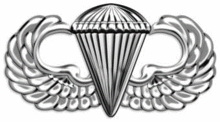Parachutist Badge (United States)
| Parachutist Badge | |
|---|---|
|
Basic Parachutist Badge (Issued by the Army, Air Force, Marine Corps, & Navy) | |
| Awarded by United States Armed Forces | |
| Type | Badge |
| Awarded for | Airborne training course |
| Status | Currently awarded |
| Statistics | |
| Last awarded | Currently awarded |
| Army Precedence | |
| Next (higher) | Expert Field Medical Badge |
| Next (lower) | Parachute Rigger Badge[1] |


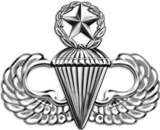
The Parachutist Badge, also commonly referred to as "Jump Wings" or "Silver Wings" is a military badge of the United States Armed Forces awarded to members of the United States Army, Air Force, Marine Corps and Navy. The United States Coast Guard is the only branch that does not issue its own Parachutist Badge, but its members are authorized to receive the Parachutist Badges of other services in accordance with their prescribed requirements. The DoD military services are all awarded the same Basic Parachutist Badge. The Army and Air Force issue the same Senior and Master Parachutist Badges while the Navy and Marine Corps issue the Navy and Marine Corps Parachutist Badge to advanced parachutists. The majority of the services earn their Basic Parachutist Badge through the U.S. Army Airborne School.
Army
The Army's Basic Parachutist Badge is awarded to all military personnel of any service who complete the US Army Basic Airborne Course at Fort Benning, Georgia. It signifies that the soldier is a trained military parachutist, and is qualified to participate in airborne operations. The badge and its sew-on equivalent may be worn on the Army Combat Uniform (ACU).[2]
The original Army Parachutist Badge was designed in 1941 by Captain (later Lieutenant General) William P. Yarborough and approved by the Department of the Army in March of that year. The Parachutist Badge replaced the "Parachutist Patch" which had previously worn as a large patch on the side of a paratrooper's garrison cap. LTG Yarborough also designed the Senior and Master Parachutist Badges and the addition of stars to portray the number of combat jumps. The flash that is worn behind the badge is also a contribution of William P. Yarborough.[3]
Basic Parachutist Badge
To be eligible for award of the basic Parachutist Badge, an individual must have completed the Basic Airborne Course of the Airborne School of the United States Army Infantry School at Fort Benning, Georgia. To graduate, a student must complete the three-phase course consisting of a ground phase, a tower phase, and a jump phase. By the end of the course, a student will have completed five jumps in varying jump configurations, from a "no load" jump all the way to a full combat load jump at night.[1]
Senior Parachutist Badge
To be eligible for the Senior Parachutist Badge, an individual must have been rated excellent in character and efficiency and have met the following requirements:
- Participated in a minimum of 30 jumps including fifteen jumps with combat equipment to consist of normal TOE equipment including individual weapon carried in combat whether the jump was in actual or simulated combat. In cases of simulated combat the equipment will include water, rations (actual or dummy), ammunition (actual or dummy), and other essential items necessary to sustain an individual in combat. Two night jumps must also be made during the hours of darkness (regardless of time of day with respect to sunset) one of which will be as jumpmaster of a stick. In addition, two mass tactical jumps which culminate in an airborne assault problem with either a unit equivalent to a battalion or larger; a separate company battery; or an organic staff of regimental size or larger. The soldier must fill a position commensurate with his or her rank or grade during the problem.
- Either graduated from the Jumpmaster Course of the United States Army Advanced Airborne School at Fort Bragg, the Airborne Department of the Infantry School or the Jumpmaster School of a separate airborne battalion or larger airborne unit, or infantry divisions and separate infantry brigades containing organic airborne elements, including the United States Army Alaska (USARAK) or the United States Army Special Operations Command (USASOC) Jumpmaster Course or served as jumpmaster on one or more combat jumps or as a jumpmaster on 15 noncombat jumps.
- Have served on jump status with an airborne unit or other organizations authorized parachutists for a total of at least 24 months.[1]
Master Parachutist Badge
To be eligible for the Master Parachutist Badge, an individual must have been rated excellent in character and efficiency and have met the following requirements:
- Participated in a minimum of 65 jumps including twenty-five jumps with combat equipment to consist of normal TOE equipment, including individual weapon carried by the individual in combat whether the jump was in actual or simulated combat. In cases of simulated combat the equipment will include water rations (actual or dummy), ammunition (actual or dummy), and other essential items necessary to sustain an individual in combat. Four night jumps must also be made during the hours of darkness, one as jumpmaster of a stick. Five mass tactical jumps must be made which culminate in an airborne assault problem with a unit equivalent to a battalion or larger; a separate company/battery; or an organic staff of regimental size or larger. The individual must fill a position commensurate with their rank or grade during the problem.
- Either graduated from the Jumpmaster Course of the Airborne Department of the Infantry School or the Jumpmaster School of a separate airborne battalion or larger airborne unit, or infantry divisions and separate infantry brigades containing organic airborne elements, including the U.S. Army Alaska Jumpmaster Course, or served as jumpmaster on one or more combat jumps or as jumpmaster on 33 noncombat jumps.
- Have served on jump status with an airborne unit or other organization authorized parachutists for a total of 36 months (may be non-consecutive).
The 25 combat equipment jumps necessary to qualify for the Master Parachutist Badge must be from a static line.[1]
The master parachutist badge is 38mm in width at the widest part of the wings and 31mm from the top of the wreath to the bottom of the parachute where the risers meet in a point.
Airborne background trimming

Soldiers assigned to Army units on airborne status wear a cloth oval background trimming underneath their Parachutist Badge,[4] which shares the basic design of the unit's beret flash.[5] This is one method by which an individual can identify a parachute qualified soldier serving in a unit on active jump status, called a "Paratrooper," versus a parachutist serving in a non-airborne unit. The original background trimming was also a contribution of William P. Yarborough.[4]
Combat Jump Device
If a soldier completes an airborne jump into a combat zone, they are authorized to wear a Combat Jump Device on their Parachutist Badge. The device consists of a star or arrangements of stars, indicating the number of combat jumps.[6] The use of stars as Combat Jump Devices did not gain official approval until after the 1983 invasion of Grenada (Operation Urgent Fury). The stars are awarded as follows:[7][8]
| One combat jump | A small bronze star centered on the shroud lines 3/16 inch below the canopy |
| Two combat jumps | A small bronze star on the base of each wing |
| Three combat jumps | A small bronze star on the base of each wing and a small bronze star centered on the shroud lines 3/16 inch below the canopy |
| Four combat jumps | Two small bronze stars on the base of each wing |
| Five or more combat jumps | A large gold star centered on the shroud lines 5/16 inch below the canopy |
| List of Known U.S. Combat Parachute Jumps[9][10] | |||||
|---|---|---|---|---|---|
| Date | Unit | Operation | Troopers | Country | Dropzone |
| 8 Nov. 1942 | 509th Parachute Infantry Battalion (PIB) | Torch | 556 | Algeria | Tafaraoui airfield, La Senia |
| 15 Nov. 1942 | 509th PIB | Torch | 300 - 350 | Algeria | Youks les Bains |
| 24 Dec. 1942 | 509th PIB, Hdqt's. Co. Two French paratroopers | 32 | Tunisia | El Djem | |
| 9 Jul. 1943 | 504th Parachute Infantry Regiment 3rd Battalion (Jumped first); 505th Regimental Combat Team (RCT), Includes: 505th PIR, 456th PFA & Co. B, 307th Engr. | Husky I | 3,406 | Italy | Gela, Sicily |
| 10 Jul. 1943 | 504th Regimental Combat Team (RCT), Includes: 504th PIR, 1st & 2nd Btn.; 376th PFA & Co.A, 307th Engr. | Husky II | 2,304 | Italy | Gela, Sicily |
| 5 Sep. 1943 | 503th PIR | 1,700 | New Guinea | Nadzab, Markham Valley | |
| 13 Sep. 1943 | 504th Regimental Combat Team (RCT) Includes: 504th PIR, 376th PFA & Co. "A" 307th Eng. | Avalanche | 1,300 | Italy | Paestum, Salerno |
| 14 Sep. 1943 | 505th Regimental Combat Team (RCT). Includes: 505th PIR, 456th PFA & Co.B 370th Engr. | Avalanche | 2,105 | Italy | Salerno, Paestum |
| 14 Sep. 1943 | 509th PIB | Avalanche | 640 | Italy | Avellino |
| 6 June 1944 | 82nd Airborne Division (507, 508) 505th RCT, Includes: 505th Parachute Infantry Reg., Co. B/307 Engineer Battlion & 456th Parachute Field Artillery Battalion. 28 Pathfinders, 504th PIR, (7 returned). | Overlord, Titanic (Dropping of parachute dummies, "Oscar"). | 6,418 | France | Normandy |
| 6 June 1944 | 101st Airborne Division [326, 377, 501, 502, 506] | Overlord, Titanic (Dropping of parachute dummies, "Oscar"). | 6,638 | France | Normandy |
| 3 July 1944 | 503rd PRCT, 1st Bn. | Table Tennis | 739 | New Guinea | Noemfoor Island |
| 4 July 1944 | 503rd PRCT, 3rd Bn. | Table Tennis | 685 | New Guinea | Noemfoor Island |
| 15 Aug. 1944 | 1st Abn. Task Force (460th PFA, 463rd PFABn.; 509th PIB; 517th PCT; 551st PIB; 596th PCEng. Co.) | Dragoon | 5,607 | France | Cote d' Azur, Riviera |
| 17 Sep. 1944 | 82nd Airborne Division (508), 505th RCT, Includes: 505th PIR, 456th PFA, & Co.B, 307th Engr.; 504th RCT, Includes: 504th PIR, 376th PFA, & Co.A, 307 Engr | Market Garden | 7,250 | Holland | Grave & Nijmegen |
| 17 Sep. 1944 | 101st Airborne Division [501, 502, 506] | Market Garden | 6,769 | Holland | Eindhoven |
| 29 Nov. 1944, 5 Dec. 1944 | Co.C, 127th Abn.Eng, Bn. Co.C., 1st Pl.., 187th P/GIR 221st AB. Med. Co.; 457th PFA 11th Abn. Div. Hdqt's Group 511th Pcht. Signal Co. 11th Abn. Div. RECON Pl. | Tabletop | 241 | Leyte | Manarawat |
| 3 Feb. 1945 | 511th PIR, 457th FABn. | Shoestring | 1,830 | Philippines | Tagaytay Ridge |
| 16 Feb. 1945 | 503rd PRCT, 462nd PFABn; 161st Airborne Engr. Btn. | Topside | 2,050 | Philippines | Corregidor |
| 23 Feb. 1945 | 511th Parachute Infantry Regiment: 1st Btn., Co.B; Hdqt's Co., 1st Btn.; Hdqt's Co., 1st Btn., Light Machine Gun Platoon | Rescue 2,147 internees | 130 | Philippines | Los Banos Prison Camp |
| 24 Mar. 1945 | 17th Airborne Division (507 PIR, 513 PIR, 464 PFA, 466 PFA, 139 AEB, 224 AMC, 155 AAB, 411 AQM, 517 ASC, 680 GFA 681 GFA, 717 AOC & 194 GIR). Also small units: MP's, Division Artillery, Reconnaissance Platoon, & Parachute Maintenance Co. | Varsity | 4,964 | Germany | Wesel |
| 23 June 1945 | 511th PIR | Gypsy | 1,030 | Philippines | Aparri |
| 20 Oct. 1950 | 187th ARCT, 2nd Battalion | DZ Easy | 1,203 | Korea | Sukchon |
| 20 Oct. 1950 | 187th ARCT, 1st, 3rd. Bn's. | DZ William | 1,470 | Korea | Sukchon |
| 21 Oct. 1950 | 187th Airborne Regimental Combat Team (ARCT). | DZ William | 671 | Korea | Sukchon |
| 23 Mar. 1951 | 187th ARCT, 2nd & 3rd Bns; 674th ABN Field Artillery Bn; 2nd & 4th ABN Ranger Cos, and Indian army surgical team. | Tomahawk | 3,486 | Korea | Munsan-Ni |
| 12 Feb. 1962 | FTT-1 White Star SF Team | Nam Beng Valley Campaign vs. Pathet Lao | 12 | Laos | Nam Tha airstrip |
| 2 Jan. 1963 | Joint General Staff reserve ARVN Paratroopers with U.S. MACV "Red Hat" Advisors from Saigon | Ap Bac | 300 South Vietnamese, 2 Americans | South Vietnam | Ap Tan Thoi |
| 22 Feb. 1967 | 173rd Airborne Brigade, 503rd P.I.R., 2nd & 3rd Btl's,; 3/319 Airborne Field Artillery Regiment (AFAR). | Junction City | 845 | Vietnam | Katum |
| 2 Apr. 1967 | 5th Special Force Group (ABN), 1st Special Forces: Detachments, A-503 Mike Force & A-344, Operation Harvest Moon (Includes Montagnards) | Harvest Moon | 356 (includes Montagnards) | Vietnam | Bunard, Phouc Long "Happy Dragon" Province |
| 5 Sep. 1967 | USMC, 1st Long Range Reconnaissance Patrol (LRRP) | Oregon | 10 | Vietnam | South |
| 5 Oct. 1967 | 5th Special Force Group (ABN), 1st Special Forces: Pathfinder Detachment (12 SF, 37 ARVN Pathfinders), "B" Co II CTZ (Pleiku) Mike Force (50 SF) & 275 LLDB (Includes Montagnards) | Blue Max | 374 | Vietnam | Bu Prang CIDG fighting camp, Quang Duc "Great Virtue" Province |
| 1968-73? | Military Assistance Command Vietnam, Studies and Observations Group (MACV-SOG) Airborne Studies Group (SOG 36) | Eldest Son, Italian Green, Pole Bean | North Vietnam, Laos, Cambodia | ||
| 28 Nov. 1970 | Team RT Florida, Special Operations Group (SOG) | 6 troopers, one ARVN officer and 2 Montagnards | Laos | NVA road, just inside LAOS | |
| 7 May 1971 | Team RT Alaska, Special Operations Group (SOG) | 4 troopers | Laos | Ashau Valley, near Laotian Highway 921 | |
| 22 June 1971 | Team One Zero, Special Operations Group (SOG) | 4 troopers | Vietnam | 60 miles SW of Danang | |
| 22 Sep. 1971 | Team Storter, Special Operations Group (SOG) | 4 troopers | Vietnam | Plei Trap Valley, NW of Pleiku | |
| 11 Oct. 1971 | Team RT Wisconsin, Special Operations Group (SOG) | 5 troopers and 5 Montagnards | Vietnam | 25 miles, SW of Pleiku in the Ia Drang Valley | |
| 25 Oct. 1983 | 75th Ranger Regiment LRS Detachment, 82nd Abn Div. combat controllers (CCT), Air Force Special Operations Command (AFSOC), 12 troopers; 4 troopers, 1st Bn, tactical air control parties (TACP). | Urgent Fury | 16(?) | Grenada | Point Salines |
| 25 Oct. 1983 | SEAL Team | Urgent Fury | 11 | Grenada | Governor's residence |
| 25 Oct. 1983 | 75th Ranger Regiment 1st, 2nd.Bns. & Two paratroopers: Sgt. Spain and SPC Richardson, 618th Engineer Co., 307th Engineer Btn., | Urgent Fury | 500 | Grenada | Point Salines airfield |
| 20 Dec. 1989 | UNIT: (0100) Rangers, 75th Inf. Reg., Task Force Red, 1,300 troops; 82nd Abn. Div. Ready Brigade (DRB), 2,700 troops. | Just Cause | 4,000 | Panama | Rio Hato east to Fort Cimarron |
| 20 Dec. 1989 | (0124) Rangers; (0145) 82nd Abn. Div., 1st Brigade Task Force: 1/504th PIR, 1/505th PIR; 2nd Bn., 504th PIR; 4th Bn., 325th Abn. Inf. Reg., Co. B and C; A Co., 3/505 PIR; 3rd Bn., 73rd Abn. Armor Reg.; 82nd Abn. MP Co., 3 platoons (0411). All joined to form: Task Force Pacific. | Just Cause | 2,176 | Panama | Torrijos-Tocumen Airport |
| 15 Jan. 1991 | Special Forces, HALO team | Desert Storm | 12 | Iraq | Northwest desert |
| 19 Oct. 2001 | 75th Ranger Regiment | Operation Enduring Freedom | 200 | Afghanistan | Objective Rhino at Dry Lake Airstrip |
| 26 Mar. 2003 | 173rd Airborne Brigade | Operation Iraqi Freedom | 954 | Iraq | Bashur Drop zone |
| 30 May 2007 | ODA 074 (HALO Team), 3rd Battalion, 10th Special Forces Group | Operation Iraqi Freedom | 11 | Iraq | |
Air Force
Like the Army, the Air Force issues the same parachutist badges in the same three degrees (Basic, Senior, & Master) but have different criteria for the awarding of these badges. The level of degree is determined by the number of jumps the wearer has successfully completed, years of service on jump status, and other requirements as specified by AFI 11-402, Aviation and Parachutist Service, Aeronautical Ratings and Badges.[11]
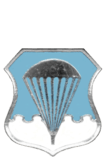
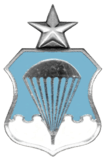
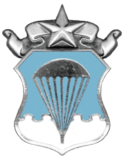
In 1956 the Air Force began issuing a unique Basic, Senior, and Master Parachutist Badges. These parachutist badges were modeled after the Air Force's Medical Badges. Due to popular demand, the Air Force decided to revert to issuing the Army style parachutist badges in 1963.[12]
Common recipients of Air Force Parachutist Badges include:
- Air Force Combat Control Teams / Special Tactics Officers
- Air Force Pararescuemen / Combat Rescue Officers
- Air Force Special Operations Weather Technicians
- Air Force Tactical Air Control Party (TACP) members
- USTRANSCOM's Joint Enabling Capabilities Command, Joint Communications Support Element (JCSE) personnel
- Note: USAF personnel assigned to the Airborne portion of the USAF's Joint Communications Support Squadron (JCSS) and JCSE (to include those JCSS in the Air National Guard) consist of a limited number of personnel within the larger USAF communications and cyber career fields and not all personnel in those career fields.
- USAF Joint Communications Support Squadron (JCSS) personnel
- Air Force Survival, Evasion, Resistance and Escape (SERE) Specialists
- Air Force Security Forces Contingency Response Group personnel
- U.S. Air Force Academy cadets and selected Air Force Reserve Officer Training Corps cadets who complete USAFA's Airmanship 490 (AM-490) course,[13] or the U.S. Army's Basic Airborne Course at Fort Benning, GA[14]
- Rapid Engineer Deployable Heavy Operational Repair Squadron Engineers[15] (RED HORSE)
- Note: USAF Airborne RED HORSE personnel consist of a limited number of USAF personnel within selected USAF civil engineering squadrons and RED HORSE squadrons, not the entire career field.
- Air Force Aircrew Flight Equipment (Parachute Rigger) Specialists[16]
- Note: Most aircrew, flight equipment, and life support technicians do not attend Airborne training nor serve on jump status.
- Air Force Aerospace and Operational Physiology Technicians[17]
- Note: Most Aerospace and Operational Physiology Technicians do not attend Airborne training nor serve on jump status unless they are assigned to High Altitude Airdrop Mission Support (HAAMS) teams.
Basic Parachutist Badge
The Air Force Basic Parachutist Badge is the same as the Army Basic Parachutist Badge. Air Force personnel may be awarded the decoration following completion of basic parachute training through a designated Air Force Air-Ground Training Program. Air Force personnel generally earn the basic parachutist badge either through the Army's Airborne School at Fort Benning, or USAFA cadets and USAF officers who graduated from USAFA through completion of the AM-490 freefall parachute training course taught by AETC's 98th Flying Training Squadron (98 FTS) at the U.S. Air Force Academy.[11]
The freefall program is offered to U.S. Air Force Academy cadets and, as a result, a large percentage of Air Force Academy graduates wear the Basic Parachutist Badge. The course is designed for USAFA cadets to develop character, confidence, and courage. The course, however, does not qualify a graduate for Department of Defense jump units. Air Force members interested in pursuing a job requiring jump status must attend the United States Army Airborne School.[13] [14]
Senior Parachutist Badge
The Air Force Senior Parachutist Insignia consists of the standard Air Force Parachutist with a star atop the parachute. Awarded for 30 static line jumps with a minimum of 24 months of cumulative time on jump status. Those 30 jumps must include: (1) Two jumps during the hours of darkness; (2) 15 jumps with operational equipment (prescribed by MAJCOM); (3) Two jumps with an operational unit that ended in an airborne assault or operational problem (real or training), or four test jumps with experimental equipment; (4) Actually perform one night jump as a Primary Jumpmaster (PJM); and (5) Seven jumps performing as PJM.[11]
Master Parachutist Badge
The Air Force Master Parachutist Insignia consists of the Senior Air Force Parachutist with a star centered within the wreath. Awarded for 65 static line jumps with a minimum of 36 months of cumulative time on jump status. The 65 jumps must include (1) Four jumps during the hours of darkness; (2) 25 jumps with operational equipment as prescribed by the MAJCOM; (3) Five jumps with an operational unit culminating in an airborne assault or operational problem (real or training), or ten test jumps with experimental equipment; (4) Two night jumps performing PJM duties; and (5) 15 jumps performing as PJM.[11]
Army and Air Force Freefall Parachutist Badges
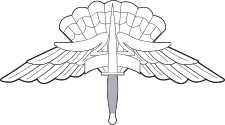
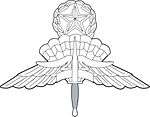
Qualified Army and Air Force personnel may go on to earn the Military Freefall Parachutist Badge in special operations training for High Altitude Low Opening (HALO) and High Altitude High Opening (HAHO) jumps. HALO/HAHO training is conducted by Company B, 2nd Battalion, 1st Special Warfare Training Group (Airborne) of the US Army Special Operations Command and lasts four weeks. It is awarded in two degrees: Basic and Master. As with the Army's Parachutist Badges, the Freefall Parachutist Badges awarded to Army personnel are also eligible for Combat Jump Devices. The last awarding of a Freefall Parachutist Badge with Combat Jump Device was in 2008 for a 30 May 2007 HAHO jump by ODA 074, 3rd Battalion, 10th Special Forces Group in Iraq.[1][8][10]
Navy and Marine Corps
The United States Navy and Marine Corps issue parachutist insignia in two degrees: the U.S. Military Basic Parachutist Badge, also called the Basic Parachustist Insignia (the same badge that's awarded to all DoD military services), and the Navy and Marine Corps Parachutist Insignia. Parachutist insignia is available to personnel who perform jumps as a:[18]
- Static-Line Parachute Jumper,
- Military Free-Fall Parachute Jumper, and
- High Altitude Low Opening (HALO) Parachute Jumper (used for premeditated personnel parachute (P3) operations).
Training is accomplished by successful completion of the prescribed course of instruction while attending the:[18]
- U.S. Army Basic Airborne Course,
- U.S. Army Basic Military Free-Fall Parachutist Course, or
- other training certified by Chief of Naval Education and Training (CNET) or approved by the Chief of Naval Operations (CNO).
Basic Parachutist Insignia
The right to wear the Basic Parachutist Insignia is based on the completion of prescribed training defined in MCO 3120.11.:[18]
When an enlisted member initially qualifies as a static line parachutist, an entry shall be made on NAVPERS 1070/613 (commonly referred to as a "Page 13" entry) of the service record indicating the date of qualification, type(s) of aircraft in which qualified, and unit at which the training was received. Enlisted members are authorized the parachutist (PJ) designator added to their rating.[18]
A qualified static-line parachute jumper who successfully completes the prescribed program of instruction while attending a formal, interservice training facility including a minimum of 10 military free-fall parachute jumps, at least 2 of which must have been conducted carrying full combat equipment (1 day/1 night), may qualify. Enlisted members are authorized the military free-fall parachutist (FPJ) designator added to their rating.[18]
When an officer initially qualifies as a static line parachutist, the additional qualification designator (AQD) of BT1 will be entered into the officer's record by their detailer (NAVPERS). Free-fall qualification will result in an AQD of BT2.[18]
For both Static Line and Military Free Fall Parachutist qualified personnel, a service record entry shall also indicate whether or not the member is HALO-qualified.[18]
The Basic Parachutist Badge is a prerequisite for the Special Warfare Badge since parachutist training is an integral part of the Navy’s Basic Underwater Demolition/SEAL (BUD/S) program. SEAL personnel generally do not wear the Basic badge once they earn their Special Warfare insignia, but will wear their Navy and Marine Corps Parachutist Badge in addition to the Special Warfare Badge, the latter nicknamed the "Budweiser" badge. Navy EOD technicians are generally also jump qualified with a number of them also being qualified in military free-fall (HALO/HAHO). Currently, due to a recent change, newly pinned Navy EOD technicians are required to attend the U.S. Army's Basic Airborne School upon graduation. As well, a small number of SWCC personnel earn Basic Parachutist badges in conjunction with their assignment to a Special Boat Team detachment that uses the Maritime Craft Air Delivery System (MCADS). This enables them to drop small watercraft and their crews from C-130 aircraft.[18]
Navy and Marine Corps Parachutist Insignia
The Navy and Marine Corps Parachutist Insignia (originally issued as Navy Parachute Rigger wings) is a gold-colored embroidered or metal insignia depicting an open parachute with outstretched wings. It is authorized for officers and enlisted personnel who were awarded the Basic Parachutist Insignia and, under competent orders, have completed a minimum of five additional static-line or P3 jumps, to include: (1) combat equipment day jump, two (2) combat equipment night jumps, and employ at least two (2) different types of military aircraft.[18]
The U.S Navy and Marine Corps Parachutist badge was originally known as the U.S. Navy Certified Parachute Rigger badge and designed by American Insignia Company in 1942 for graduates of the U.S. Navy Parachute Rigger School. During WWII, despite being against uniform regulations it became common for U.S. Marine Corps paratroopers who were issued the silver U.S. Army Basic Parachutist badge to wear the gold Navy Certified Parachute Rigger badge because they believed the gold "Rigger wings" looked better on their uniform.[19] This out of regulations wearing of the Parachute Rigger badge became so common that in July 1963, the Commander of United States Marine Corps Force Reconnaissance Bruce F. Meyers sent a request to the Chief of Naval Operations Admrial George W. Anderson Jr. via Marine Corps Commandant General David M. Shoup requesting to officially make the Navy Parachute Rigger badge the parachutist badge for the Navy and Marine Corps. The request was approved by Admiral Anderson on July 12, 1963 per BuPers Notice 1020.[20] Since 1963, being a graduate of the U.S. Navy Parachute Rigger School is no longer a requirement to earn the badge.
See also
References
- 1 2 3 4 5 U.S. Army Regulation 600-8-22, Military Awards, Official Department of the Army Regulation, dated 11 Dec 06, revised 15 Sep 11, last accessed 4 Oct 11
- ↑ Army Directive 2011-11, Change to Wear of the Army Combat Uniform (ACU) Items, Secretary of the Army, 13 June 2011, last accessed 18 February 2013
- ↑ Born, K (1998). "U.S. Army Parachute Badge". US Army Quartermaster Museum. Retrieved 2008-11-22.
- 1 2 Lanham, Howard G. (2001). "Insignia of Airborne Units U.S. Army". American Military Patches, Other Insignia and Decorations of World War Two. Retrieved 2008-11-15.
- ↑ "Beret Flashes and Background Trimmings". The Institute of Heraldry. United States Department of the Army. Archived from the original on 2008-08-22. Retrieved 2008-11-15.
- ↑ "US Army Badges". US Army Institute of Heraldry. Retrieved 8 February 2010.
- ↑ U.S. Army Parachute Badge, U.S. Army Quartermaster Museum, last accessed 18 February 2013
- 1 2 Army Regulation 670-1, Wear and Appearance of Army Uniforms and Insignia, dated 3 February 2005, revised 11 May 2012, accessed 1 June 2012
- ↑ United States Combat Jumps, GlobalSecurity.org, last updated 7 May 2011, last accessed 17 February 2013
- 1 2 Hitting the ground with coalition partners; Special Warfare Magazine; Valume 21, Issue 6; dated November–December 2008, last accessed 17 February 2013
- 1 2 3 4 AFI 11-402, Aviation and Parachutist Service, Aeronautical Ratings and Badges, U.S. Air Force Instructions, dated 13 December 2010, last accessed 11 January 2014
- ↑ Obsolete USAF Insignia, USAF Flag Ranks website, last accessed 1 June 2012
- 1 2 "AIRMANSHIP 490 - Frequently Asked Questions". Air Education and Training Command. United States Air Force. Retrieved 2008-11-15.
- 1 2 U.S. Air Force ROTC - College Life - Summer Programs - Parachuting. Afrotc.com. Retrieved on 2010-08-20.
- ↑ Airborne RED HORSE (Combat Engineers). Usmilitary.about.com. Retrieved on 2010-08-20.
- ↑ Air Force Enlisted Job Descriptions, 1P0X1-Aircrew Equipment, About.com Guide, by Rod Powers, last accessed 18 February 2013
- ↑ Air Force Enlisted Job Descriptions, 4M0X1-Aerospace Physicolgy, About.com Guide, By Rod Powers, last accessed 18 February 2013
- 1 2 3 4 5 6 7 8 9 U.S. Marine Corps Order 3120.11, U.S. Marine Corps Parachuting Policy and Program Administration, dated 4 May 2009, last accessed 18 February 2013
- ↑ Mason, Chris (2004). Paramarine!: Uniforms and Equipment of Marine Corps Parachute Units in World War II. Schiffer Pub Ltd. pp. 175–177. ISBN 9780764319242.
- ↑ "Evolution of Naval Wings" (PDF). Coast Guard Aviation History. THE U.S. COAST GUARD AVIATION ASSOCIATION.
External links
| Wikimedia Commons has media related to Parachutist Badges of the US Army. |
